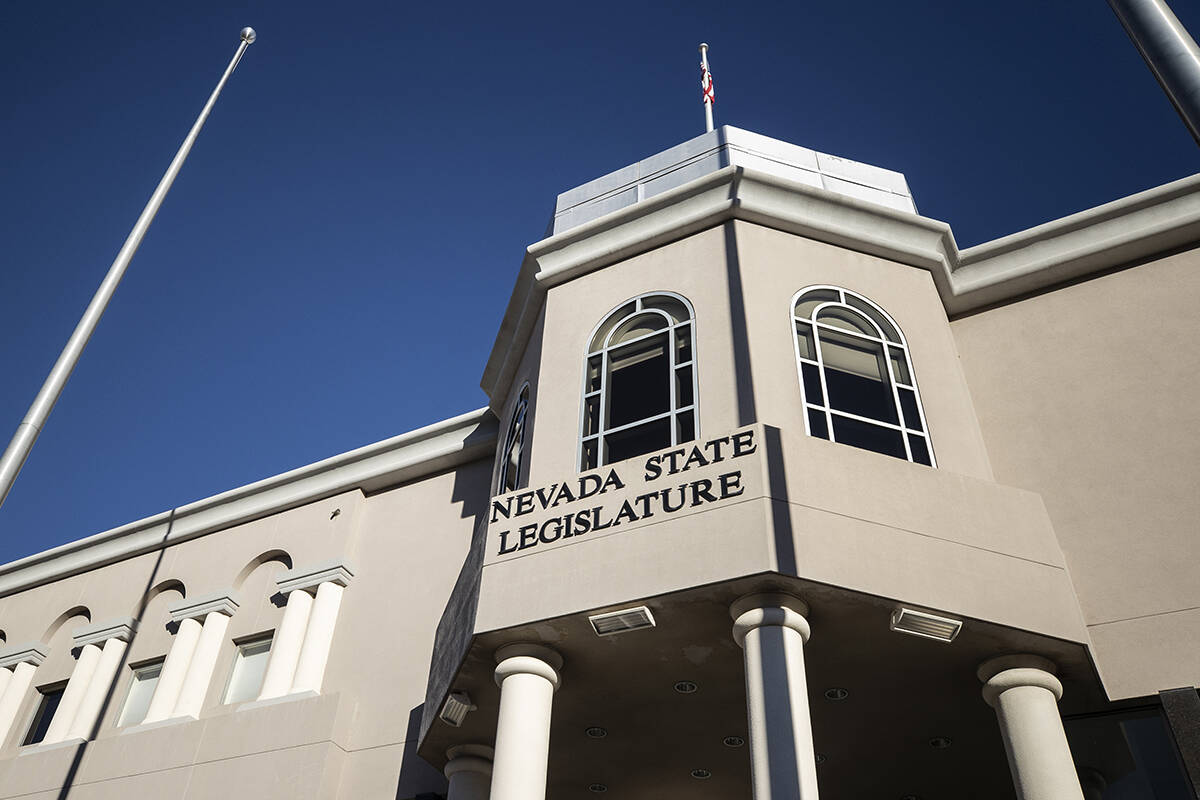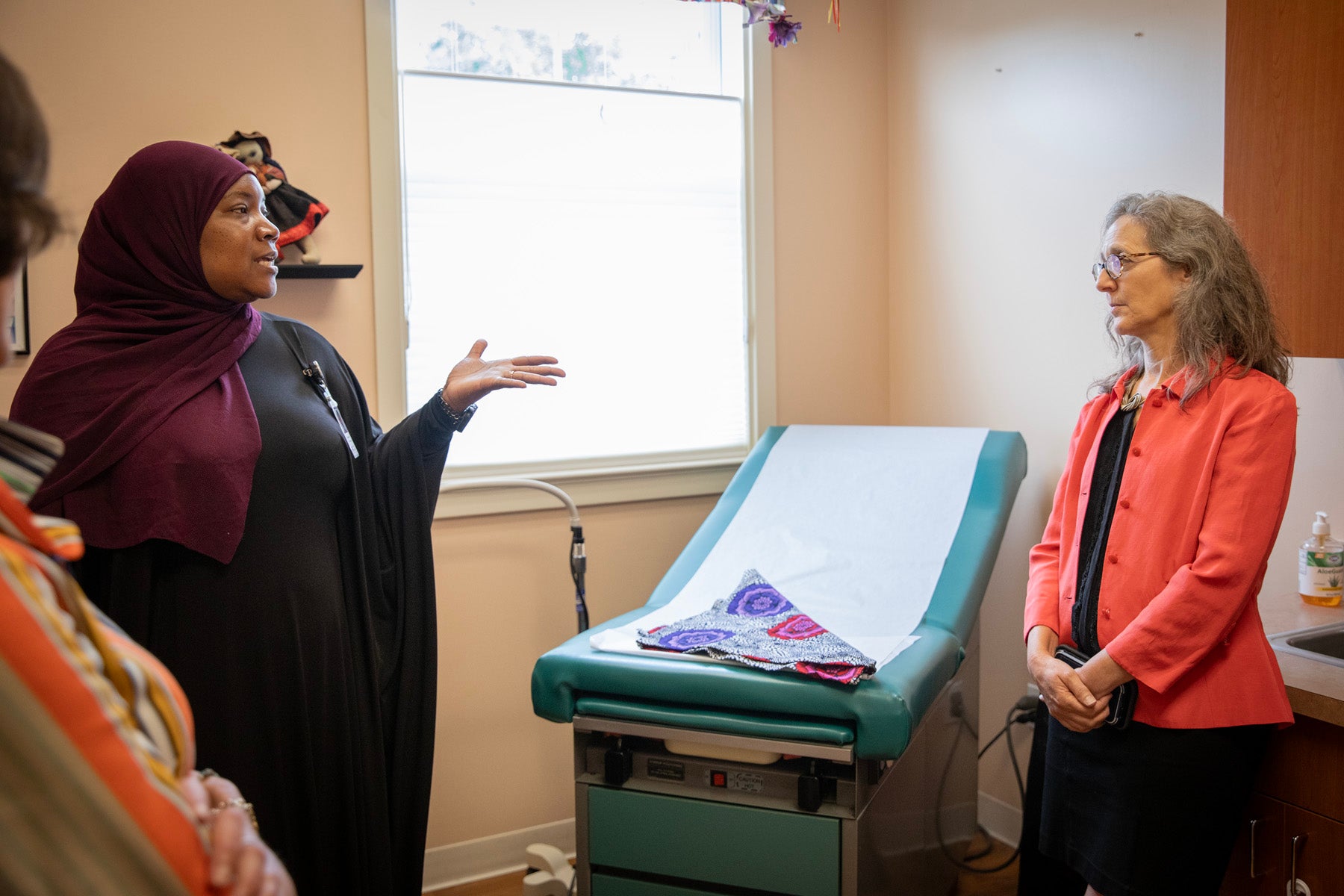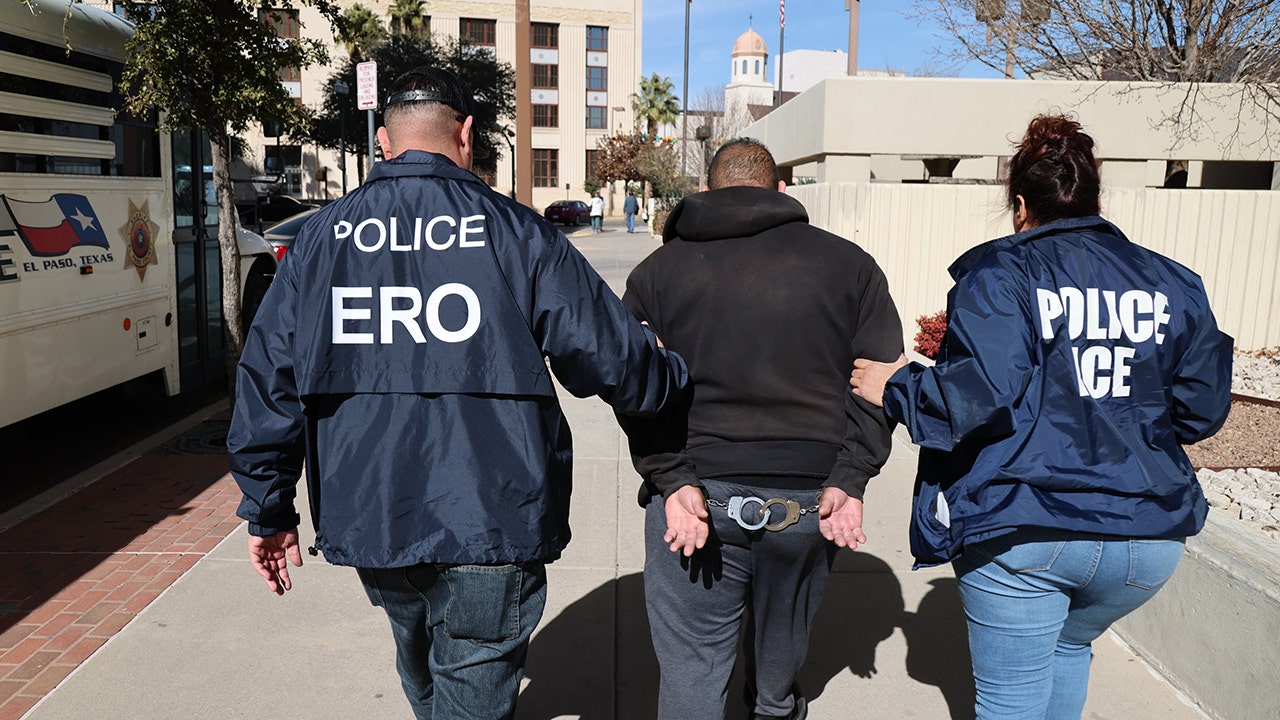Nevada
Behind the scenes of rural maternal health care reporting in Nevada

KUNR’s Lucia Starbuck just wrapped up her four-part series about maternal health care deserts in rural Nevada and the role doulas can play. She sat down with Morning Edition host Lori Gilbert of KNCC, KUNR’s sister station, to pull back the curtain and chat about what went into this project.
LORI GILBERT: This is a broad topic, and I’m curious as to how the project came about and how you went about finding some subjects and people to talk to.
LUCIA STARBUCK: This [series] has really been my baby. The idea really started forming back in the spring. We got a press release from Nevada Medicaid saying, “Hey, we’re going to increase the Medicaid reimbursement rate for doulas if you make sure your client follows through on a dentist appointment,” I was like, “Okay, problem solved.” And then I talked to some doulas, and they’re like, that doesn’t quite meet the cost of living, but we’re working on this bill to triple that Medicaid reimbursement rate.
So I was following that during the legislative session and then seeing that March of Dimes report that said more than half of Nevada counties are considered maternal health care deserts. I was super curious about the role that doulas can play.
It’s been just a wonderful journey, letting health care researchers and health care organizations know I’m working on this project, and they’re pointing me to traveling providers. I also had a survey that I distributed online and at places like libraries and daycares in rural Nevada for expectant parents and people who have recently given birth to share their experiences with us.
GILBERT: Was there any event or person from the reporting that you were doing that really stood out for you?
Courtesy of Lucia Starbuck
STARBUCK: One event that I really enjoyed was the rural EMS conference in Elko. A couple folks told me at the beginning of the project, “Hey, are you aware that rural EMS plays a role in maternal health care?” and that wasn’t really something that I had on my mind. So that really opened my eyes to kind of who is responding to these calls.
Meeting with the doulas was really cool. A lot of times, I would be in an interview or talking with a group of people, and it would actually be like all women in the room, and that was like really cool to see and be a part of and talk so vulnerably about issues impacting moms in rural Nevada.
Something that I also really enjoyed was our own event. We brought together three moms, two rural doulas, a rural doula in training, a rural midwife, and a community health organization. And we had a roundtable in Fallon to talk about the problems and the solutions they would like to see.
GILBERT: It sounds as though it really helped shape your perspective. What was that listening session like?

Kat Fulwider
/
KUNR Public Radio
STARBUCK: I met this doula based in Fallon. After interviewing a couple of the moms that she worked with, a couple of moms did not have the pregnancy experience that they had hoped for. They asked me, “I don’t know if you’ve ever heard this before,” or, “I feel kind of alone.” And I took a second to say, “I’ve actually heard this from other people.” I was curious if there would be space for bringing people together in a room to say, you know, you’re not the only one who has had this experience in rural Nevada with a doula.
Another thing that I loved about this event, I asked everyone to bring their own question and pose it to the group. And the Fallon doula asked, “What can I do better?” And people had concrete advice for her.
GILBERT: You strike a common theme, you know, along this long road to maternal health care, and something we’re used to living in rural communities: it can be isolating. The doula provides this kind of relationship that someone would need, especially if you’re a first-time mom. What do you hope people will take away from listening to your four-part series?
STARBUCK: It’s really important for me for this to be documented. When I first started, I heard a million anecdotes but not a lot of news coverage. And, of course, I’m the politics reporter, so I hope it affects policy changes.
People told me they would like to see birth centers in rural Nevada. They just want to see a provider in their own community; they don’t want to travel. I heard a lot that there are low numbers of births and babies being born, so it doesn’t justify having these resources out there; however, there are still parents and families and people who are pregnant living in rural Nevada.
I really hope that lawmakers, especially our rural lawmakers, can pay attention to this.
GILBERT: This is just one snapshot as you focused on maternal health care. But throughout rural Nevada, Nevadans are traveling for other types of care.

Kat Fulwider
/
KUNR Public Radio
STARBUCK: Yes, it’s not just maternal health care. It’s cardiology [and] optometry. Where are people getting cancer treatments? It’s primary care as well.
Something that I heard again and again is that rural community members are used to driving, and people kind of told me with a chuckle, but it made me very concerned. I was like, “How many miles are you adding to your car? Are you having to take time off work? Who’s watching your kids?”
I really want to continue reporting on different types of health care and health care gaps and where the resources are. If you’re affected by any of this, please don’t hesitate to reach out.
KUNR’s Lucia Starbuck reported this series while participating in the USC Annenberg Center for Health Journalism’s 2023 National Fellowship.

Nevada
Crash on N Nevada closes several lanes of traffic in Colorado Springs

COLORADO SPRINGS, Colo. (KKTV) – On Thursday around 4:10 p.m. a crash at southbound N Nevada Avenue and Mount View Lane blocked several lanes of traffic.
The City of Colorado Springs said the left northbound turn lane and right, left and center southbound lanes were closed.
As of 4:27 p.m., there were no updates on when those lanes would reopen.
Update: Crash SB N Nevada AV & Mount View Ln, blocking the right lane. Left turn lane NB is closed.Also left and center lanes SB are closed.
— Colo Spgs Traffic (@COSTraffic) January 16, 2025
Copyright 2025 KKTV. All rights reserved.
Nevada
Why does Nevada have a short legislative session?

The Nevada Legislature begins its lawmaking session on Feb. 3, starting a 120-day spirit to get hundreds of bills considered before the Legislature adjourns until 2027.
Nevada is one of four states that meets biennially (the others being Montana, North Dakota and Texas). The state’s 21 senators and 42 assemblymen and assemblywomen have about four months every odd year to introduce bills, update laws, establish the biennial budget and any other legislative work that may come up.
This year, the Legislature will adjourn – called sine die – on Monday, June 2.
Part-time legislatures, also known as citizen legislatures, were more common in state governments in the past, according to David Damore, a UNLV professor of political science. But a “legislative professionalism” movement in the 1960s and 1970s changed that for many other states.
“Over time, consistent with Nevada’s libertarian ethos, there’s been a tug of war between the people and the Legislature through direct democracy,” Damore said.
The Nevada Constitution originally called for regular sessions to be no longer than 60 days. In the early to mid- 20th century, however, sessions went longer but were only officially recorded at 60 days long. In 1958, voters removed that limitation from the Constitution and sessions grew lengthier until 1998. Then, voters approved a constitutional amendment limiting each legislative session to 120 days.
Damore said the part-time legislature plus term limits – also established through a voter-approved constitutional amendment – can make lawmaking more challenging.
“One of the criticisms of that is because of the turnover and lack of staff support, there’s a real reliance on party caucusing for determining how people are going to vote,” he said. “Party-line voting goes up because that’s the cue they take – the only one that’s really available to them.”
It’s possible for lawmakers to work more than four months in a year, though. The governor has the power to call a special session, bringing lawmakers back to Carson City for a specific purpose. In 2023, for instance, Gov. Joe Lombardo called a special session that lasted eight days to establish state funding for a Major League Baseball stadium on the Las Vegas Strip.
A petition of two-thirds of the members of each house can also convene a special session, though that has yet to happen in the state’s history, according to a 2023 report from the Legislative Counsel Bureau.
Contact McKenna Ross at mross@reviewjournal.com. Follow @mckenna_ross_ on X.
Nevada
Nevada Gov. Lombardo seeks stiffer penalties for theft, faster election results
Striking an optimistic tone and urging bipartisanship, Gov. Joe Lombardo delivered a State of the State address Wednesday night with proposals to finish vote counting on Election Day, make more thefts qualify as felonies, and get more homes and apartments built.
“The state of our state is steadily improving,” he said. “We are certainly headed in the right direction and the outlook is positive.”
“Combining the collective will of the 63 of you and me, we can build more than houses; we can convert Nevada’s promise into reality, a place where every family can thrive, every community can grow, and every dream can find a home,” Lombardo said, referencing the number of state Senate and Assembly members. “That’s the Nevada way.”
The Republican governor’s desire to work together this year comes as no surprise given that in 2023, the majority-Democrat Legislature called Lombardo’s bluff by passing bills the governor said he wouldn’t sign. He delivered a record 75 vetoes.
After November’s election, he still faces a Legislature where Democrats dominate but do not hold a supermajority, making his veto pen a real threat in negotiations. Bipartisanship will be required to get approval for significant bills.
His remarks were greeted with punctuations of applause from lawmakers on both sides of the political aisle. Along with frequent water-bottle breaks, he got looser as he went along, smiling, addressing people in the gallery and going off-script to make a few jokes.
He announced a $12.7 billion budget that he said would make teacher pay raises permanent and extend them to charter school teachers.
The next legislative session starts Feb. 3 and officially lasts 120 days.
Nevada Gov. Lombardo’s top 5 proposals
Lombardo, a former Clark County sheriff, summarized five priorities he plans to push in the Legislature.
Before announcing them, he told the gallery of lawmakers at the Nevada Assembly, “I would ask that before some of you say ‘No,’ work with me, collaborate with my agency heads, ask questions, give input, offer alternatives and set aside partisan politics.”
• Nevada Housing Attainability Act: Lombardo said this proposal would streamline permits, reduce building fees and prioritize state funding that will support $1 billion in new “attainable” housing units across Nevada, rather than the buzzword of “affordable.”
He blamed Nevada’s housing crisis on the federal government’s reluctance to release some of its land — it controls more than 80% of the state — and said that he expects President-elect Donald Trump to help make that happen “but, while we press for federal action, we’re not waiting.”
Also highlighted was the recent approval of a $200 million public-private partnership to provide homeless services called the Campus for Hope.
• Nevada Healthcare Access Act: Lombardo noted that, “With some of the lowest provider-to-patient ratios in the nation, far too many Nevadans are left waiting for care or worse, going without it.”
To partly address this, he said, he would propose that by 2028, all health insurance plans in Nevada will be required to adopt standardized and digitized prior authorization plans, reducing delays for patients and providers.
He said he would double the state’s investment in graduate medical education and incentivize providers to set up in underserved areas. The plan would also create an Office of Mental Health to expand access to behavioral health services and improve coordination of care.
• Nevada Accountability in Education Act: Lombardo said he would revisit his efforts to expand school choice, after noting he’s unsatisfied with Nevada consistently ranking near the bottom nationally on education measurements.
“No child should be trapped in a failing school because of their ZIP code or held down because of how much their parents or grandparents earn,” he said.
He added his bill proposal would include “transportation support” to help families choose other schools for their children.
• Nevada Safe Streets and Neighborhoods Act: This would reduce the amount of a theft that would trigger a felony charge and increase penalties for repeat offenders.
It would also prohibit the use of diversion courts for offenders who commit crimes against children or the elderly.
• Economic Development Policy Reform Act: Earlier in his remarks, Lombardo mentioned Nevada’s highest-in-the-nation unemployment rate of 5.7%. His economic plan would give tax credits to childcare facilities so that they could potentially charge lower rates and help more people enter the workforce.
• Creating More Government Effectiveness: He vowed to evaluate each of the state government’s more than 300 boards and commissions to see which ones have outlived their usefulness.
Democratic responses to Gov. Lombardo
Speaker of the Nevada Assembly, Democrat Steve Yeager, gave a recorded response to Lombardo’s State of the State.
“This past November, Nevada voters again overwhelmingly voted for Democrats to lead our state Legislature,” he said.
Asking the governor not to break his veto record from the previous session, he urged that Lombardo work with Democrats while also emphasizing differences with Republicans.
Democratic legislators, he said, will:
- Strongly reject any Republican efforts to restrict abortion rights.
- Oppose any proposal that would make it harder to vote — despite lopsided support for a voter ID law in November.
- Prioritize “common sense gun violence prevention measures because guns are all too often used in violent crime.”
In response to Lombardo’s crime proposal, Yeager said, “We must not backtrack to the failed ‘tough on crime’ legislation of the 1990s that was expensive, wasteful and ineffective without making us any safer.”
Democratic groups also released statements criticizing Lombardo.
Nevada State Democratic Party executive director Hilary Barrett sent out a lengthy, detailed memo criticizing Lombardo’s first two years in office.
“When it comes to housing, health care, education and public safety, Nevadans are measurably worse off due to the actions of Lombardo and his commitment to prioritizing powerful special interests and his own political self-interest,” she said.
Laura Martin, executive director of the Progressive Leadership Alliance of Nevada, said corporate landlords are artificially inflating housing costs and that the governor’s proposal to use federal land for more housing will make things worse.
“Lombardo’s plan that promotes urban sprawl as a solution to the housing crisis will only exacerbate the existing climate crisis, when we should be prioritizing infill,” she said.
“We should be investing in the future of Nevada by making sure our aging communities and schools are climate resilient, not with another stadium, movie studio, or mass deportations.”
Mark Robison is the state politics reporter for the Reno Gazette Journal, with occasional forays into other topics. Email comments to mrobison@rgj.com or comment on Mark’s Greater Reno Facebook page.
-
/cdn.vox-cdn.com/uploads/chorus_asset/file/25822586/STK169_ZUCKERBERG_MAGA_STKS491_CVIRGINIA_A.jpg)
/cdn.vox-cdn.com/uploads/chorus_asset/file/25822586/STK169_ZUCKERBERG_MAGA_STKS491_CVIRGINIA_A.jpg) Technology1 week ago
Technology1 week agoMeta is highlighting a splintering global approach to online speech
-

 Science5 days ago
Science5 days agoMetro will offer free rides in L.A. through Sunday due to fires
-
/cdn.vox-cdn.com/uploads/chorus_asset/file/25821992/videoframe_720397.png)
/cdn.vox-cdn.com/uploads/chorus_asset/file/25821992/videoframe_720397.png) Technology1 week ago
Technology1 week agoLas Vegas police release ChatGPT logs from the suspect in the Cybertruck explosion
-

 Movie Reviews1 week ago
Movie Reviews1 week ago‘How to Make Millions Before Grandma Dies’ Review: Thai Oscar Entry Is a Disarmingly Sentimental Tear-Jerker
-

 News1 week ago
News1 week agoPhotos: Pacific Palisades Wildfire Engulfs Homes in an L.A. Neighborhood
-

 Business1 week ago
Business1 week agoMeta Drops Rules Protecting LGBTQ Community as Part of Content Moderation Overhaul
-

 Education1 week ago
Education1 week agoFour Fraternity Members Charged After a Pledge Is Set on Fire
-

 Politics1 week ago
Politics1 week agoTrump trolls Canada again, shares map with country as part of US: 'Oh Canada!'


















